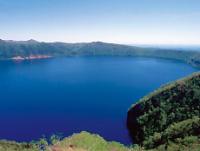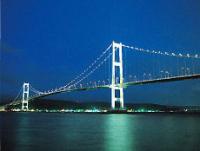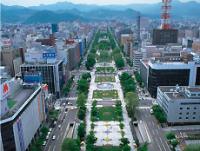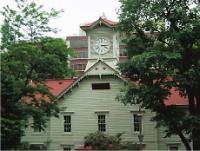History of Development in Hokkaido
History of Development in Hokkaido
The full-scale development of Hokkaido, which began with the establishment of the Kaitakushi (Development Commission), produced significant achievements with the passage of time. As railways and roads extended throughout the wilderness and more people and goods were transported through ports, a wide variety of crops began being raised on the once uncultivated land. The population of Hokkaido, which was once only about 50,000, has increased to 5.7 million, enveloping the land with vitality. As it enters into a new age, Hokkaido continues to possess new potential and frontier spirit.
Major incidents in Hokkaido’s history
| Jul. 1869 | Kaitakushi (Development Commission) established |
| Aug. 1869 | Ezo renamed Hokkaido |
| Feb. 1882 | Kaitakushi (Development Commission) abolished, three prefectures (Hakodate, Sapporo and Nemuro) established |
| Jan. 1883 | Hokkaido Project Management Bureau established at the Department of Agriculture and Commerce |
| Jan. 1886 | The three prefectures and the Hokkaido Project Management Bureau disbanded, the Hokkaido Agency established |
| 1900 | Agricultural production exceeds the production of the marine-product industry to become the nation’s number one. |
| Apr. 1901 | Hokkaido Regional Expense Act and Hokkaido Assembly Act enacted |
| Mar. 1902 | Hokkaido Irrigation Association Act enacted (paddy-field development projects thrive) |
| 1904 - 1907 | Series of railway services established (Hakodate - Otaru - Asahikawa - Kushiro, etc.) |
| 1908 | National Seikan sea route opens |
| 1920 | Industrial production exceeds agricultural production to become the nation’s number one. |
| Sep. 1926 | Telephone lines open between Tokyo and Sapporo |
| May. 1947 | Local Autonomy Act enacted, Hokkaido Agency abolished and Hokkaido Government established |
| Mar. 1949 | Hokkaido Comprehensive Development Council set up in the cabinet |
| May. 1950 | Hokkaido Development Act promulgated |
| Jun. 1950 | Hokkaido Development Agency established |
| Jul. 1951 | Hokkaido Regional Development Bureau established |
| Oct. 1951 | First-term Hokkaido Comprehensive Development Plan formulated |
| May. 1956 | Agricultural development commences in the Shinotsu and Konsen regions |
| Jun. 1956 | Hokkaido Development Finance Public Corporation established |
| Apr. 1960 | Hokkaido National Industrial Research Institute established |
| Oct. 1962 | Second-term Hokkaido Comprehensive Development Plan formulated |
| Apr. 1963 | Operations commence at Tomakomai Industrial Port |
| May. 1964 | Construction of Seikan Tunnel’s survey tunnel begins |
| Sep. 1968 | Ceremony held to mark the centenary of the development Hokkaido |
| Jul. 1970 | Third-term Hokkaido Comprehensive Development Plan formulated |
| Aug. 1971 | Basic plan of the Tomakomai Tohbu Large-Scale Industrial Base formulated |
| Aug. 1972 | Basic Plan of Development of the Ishikari Bay New Port Region formulated |
| Jul. 1973 | Construction of the Ishikari Bay New Port begins |
| Apr. 1974 | Full-scale construction of the Nemuro New Livestock Farm Village commences (Agricultural Land Development Public Corporation established) |
| Aug. 1976 | Construction of Tomakomai East Port commences |
| Feb. 1978 | Fourth-term Hokkaido Comprehensive Development Plan formulated |
| Oct. 1980 | Operations commence at Tomakomai East Port |
| Aug. 1982 | Operations commence at Ishikari Bay New Port |
| Oct. 1984 | Nemuro New Livestock Farm Village completed |
| Nov. 1987 | Seikan Tunnel completed |
| Jun. 1988 | Fifth-term Hokkaido Comprehensive Development Plan formulated |
| Jul. 1988 | New Chitose Airport opens |
| Jul. 1992 | Operations commence at New Chitose Airport’s new terminal area |
| Aug. 1995 | Tomatoh New Plan (Tomakomai Tohbu new development plan) formulated |
| Apr. 1996 | Operations commence at New Chitose Airport’s Runway B |
| Apr. 1998 | Sixth-term Hokkaido Comprehensive Development Plan formulated |
| Jan. 2001 | Ministry of Land, Infrastructure, Transport and Tourism established |
| Jul. 2008 | Seventh-term Hokkaido Comprehensive Development Plan formulated |
Era of Kaitakushi (Development Commission) (1869 – 1882)
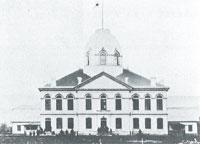
(Courtesy of Hokkaido University Library)
The Kaitakushi also invited Horace Capron, former U.S. Secretary of Agriculture, to adopt overseas technology. The introduction of American technology helped advance both development and modernization, leading to the development of capital-intensive farming, the opening of coalmines and the construction of lumber mills, breweries and canneries that made use of local resources. In 1876, Sapporo Agricultural College (the present Hokkaido University) was also established to foster personnel for development.
In 1882, the Kaitakushi was disbanded and three prefectures (Hakodate, Sapporo and Nemuro) were established instead. In the following year, the Department of Agriculture and Commerce established the Hokkaido Project Management Bureau, ushering in an age of three prefectures and one bureau.
Era of the Hokkaido Agency (1886 – 1947)
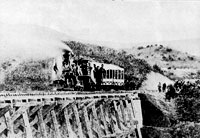
(Courtesy of Hokkaido University Library)
Against such a backdrop, the Hokkaido 10-year Plan and its subsequent Development Plans were formulated, providing the groundwork for systematic development.
With the improvement of transportation networks, the development of mines and the construction of paper mills, iron works and steel works, the foundation of modern industry was consolidated.
After World War II, the Ministry of Home Affairs was abolished under the new constitution of 1947, and the Hokkaido Agency became a local government. Meanwhile, due to food shortages and other postwar confusion, Hokkaido became the focus as a center for producing food and as a place where those returning from overseas relocated. With the enactment of the Hokkaido Development Act, the development of Hokkaido was promoted once again under a unique system.
Era of the Hokkaido Development Agency and Hokkaido Regional Development Bureau (1950 – 2000)
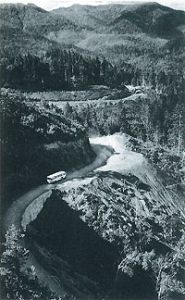
Since 1952, efficient infrastructure improvements have been promoted based on the Hokkaido Comprehensive Development Plan, including the development of power sources, construction and improvement of roads, ports and rivers, as well as increased food production.
The purposes of the Hokkaido Comprehensive Development Plans have also changed with the passage of time, from resource development, industrial promotion and industrial structure upgrading to industrial activation toward economic independence, harmonious co-existence with the rich natural environment, establishment of communities based on recycling and creation of safe and comfortable communities.
Hokkaido development administration was comprehensively promoted based on the prefecture’s local characteristics from the standpoint of the national government, and the opening of the Seikan Tunnel, New Chitose Airport and the Hakucho Bridge followed.
Hokkaido Bureau and Hokkaido Regional Development Bureau, Ministry of Land, Infrastructure, Transport and Tourism (2001 – )
The Hokkaido Development Agency, National Land Agency, Ministry of Construction and Ministry of Transport were reorganized into the Ministry of Land, Infrastructure, Transport and Tourism in January 2001. This enabled more extensive regional development to be promoted through comprehensive measures, without any harmful effects to the traditional vertically divided administration.
Hokkaido has unique natural, geographical, social and economic appeal compared with the rest of Japan and is therefore expected to contribute greatly to the development of the nation. Hokkaido development administration is thus based on two pillars: to formulate conservation and development policies while reconciling the national and regional needs, and to realize those policies based on collaboration between the public and private sectors.
The Hokkaido Regional Development Bureau is developing effective and efficient projects that meet the needs of the times.
Hokkaido has unique natural, geographical, social and economic appeal compared with the rest of Japan and is therefore expected to contribute greatly to the development of the nation. Hokkaido development administration is thus based on two pillars: to formulate conservation and development policies while reconciling the national and regional needs, and to realize those policies based on collaboration between the public and private sectors.
The Hokkaido Regional Development Bureau is developing effective and efficient projects that meet the needs of the times.
Address:Nishi 2-chome,Kita 8-jo Kita-ku, Sapporo-si, Hokkaido 060-8511 Japan
Tel:011-709-2311 Mail:hkd-ky-koho_info0@gxb.mlit.go.jp
Tel:011-709-2311 Mail:hkd-ky-koho_info0@gxb.mlit.go.jp

